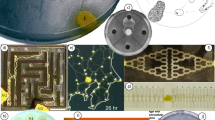Abstract
We used an artificial language as a tool for the study of spatial memory organization in a young Pan paniscus. In the first experiment, we showed the bonobo a road sign just outside its indoor sleeping area. The sign indicated, by means of arbitrarily designated geometrical shapes (lexigrams), where food was hidden. Only 2 of the 15 locations were visible from the sign. Distances ranged up to 170 m from the sign. In 99 of 127 test trials the bonobo went directly to the designated location on its first move. In a second experiment, we presented the road sign at varied points in the woods rather than at the original fixed place. In these trials the goal was a preferred toy. The bonobo's human companions were never told the location of the goal and distances were up to 650 m. In all 12 trials the bonobo led its companions to the designated place via an efficient path. The bonobo appeared to be able to move, based on the information provided by a lexigram, from almost any arbitrary starting location in its 20-ha environment to any one of the numerous goal locations.
Similar content being viewed by others
REFERENCES
Balda, R. P., and Kamil, A. C. (1992). Long-term spatial memory in Clarks's nutcracker, Nucifraga columbiana. Anim. Behav. 44: 761–769.
Benhamou, S., Sauve, J., and Bovet, P. (1990). Spatial memory in large-scale movements: Efficiency and limitations of the egocentric coding process. J. Theor. Biol. 145: 1–12.
Bennett, A. T. (1996). Do animals have cognitive maps? J. Exp. Biol. 199: 219–224.
Boesch, C., and Boesch, H. (1984). Mental map in wild chimpanzees: An analysis of hammer transports for nut cracking. Primates 25: 160–170.
Brown, G. S., and Gass, C. L. (1993). Spatial association learning by hummingbirds. Anim. Behav. 46: 487–497.
Bullock, A., and Stallybrass, O. (1977). The Harper Dictionary of Modern Thought, Harper and Row, New York.
Byrne, R. W. (2000). How monkeys find their way: Leadership, coordination, and cognitive maps of African baboons. In Boinski, S., and Garber, P. A. (eds.), On the Move: How and Why Animals Travel in Groups, University of Chicago Press, Chicago, pp. 491–518.
Cheney, D. L., and Seyfarth, R. M. (1985). Social and nonsocial knowledge in vervet monkeys. Philos. Trans. R. Soc. Lond. B 308: 187–201.
Collett, T. S. (1996). Insect navigation en route to the goal: Multiple strategies for the use of landmarks. J. Exp. Biol. 199: 227–235.
Gallistel, C. R. (1990). The Organization of Learning, MIT Press, Cambridge, MA.
Garber, P. A. (1989). Role of spatial memory in primate foraging patterns: Saguinus mystax and Saguinus fuscicollis. Am. J. Primatol. 19: 203–216.
Garber, P. A. (2000). Evidence for the use of spatial, temporal, and social information by some primate foragers. In Boinski, S., and Garber, P. A. (eds.), On the Move: How and Why Animals Travel in Groups, University of Chicago Press, Chicago, pp. 261–298.
Goodall, J. (1986). The Chimpanzees of Gombe, Belknap Press of Harvard University Press, Cambridge, MA.
Janson, C. (2000). Spatial movement strategies: Theory, evidence, and challenges. In Boinski, S., and Garber, P.A. (eds.), On the Move: How and Why Animals Travel in Groups, University of Chicago Press, Chicago, pp. 165–203.
Jarvik, M. E. (1953). Discrimination of colored food and food signs by primates. J. Comp. Psychol. 46: 390–392.
Kano, T. (1992). The Last Ape, Stanford University Press, Stanford, CA.
Kosko, B. (1986). Fuzzy cognitive maps. Int. J. Man-Machine Stud. 24: 65–75.
Menzel, C. R. (1991). Cognitive aspects of foraging in Japanese monkeys. Anim. Behav. 41: 397–402.
Menzel, C. R. (1999). Unprompted recall and reporting of hidden objects by a chimpanzee (Pan troglodytes) after extended delays. J. Comp. Psychol. 113: 426–434.
Menzel, E.W., Jr. (1973a). Chimpanzee spatial memory organization. Science 182: 943–945.
Menzel, E.W., Jr. (1973b). Leadership and communication in young chimpanzees. In Menzel, E., Jr. (ed.), Symposia of the IVth International Congress of Primatology, Vol. 1: Precultural Primate Behavior, Karger, Basel, pp. 192–225.
Menzel, E. W., Jr. (1974). A group of young chimpanzees in a one-acre field. In Schrier, A. M., and Stollnitz, F. (eds.), Behavior of Nonhuman Primates, Vol. 5, Academic Press, New York, pp. 83–153.
Menzel, E.W., Jr. (1984). Spatial cognition and memory in captive chimpanzees. In Marler, P., and Terrace, H. S. (eds.), The Biology of Learning, Springer-Verlag, New York, pp. 509–531.
Menzel, R., Geiger, K., Chittka, L., Joerges, J., Kunze, J., and Muller, U. (1996). The knowledge base of bee navigation. J. Exp. Biol. 199: 141–146.
Meyer, D. R., Treichler, F. R., and Meyer, P. M. (1965). Discrete-trials training techniques and stimulus variables. In Schrier, A. M., Harlow, H. F., and Stollnitz, F. (eds.), Behavior of Nonhuman Primates, Vol. 1, Academic Press, New York, pp. 1–49.
Miller, N. E., and Dollard, J. (1941). Social Learning and Imitation, Yale University Press, New Haven, CT.
Muller, R. U., Stead, M., and Pach, J. (1996). The hippocampus as a cognitive graph. J. Gen. Physiol. 107: 663–694.
Poucet, B. (1993). Spatial cognitive maps in animals: New hypotheses on their structure and neural mechanisms. Psychol. Rev. 100: 163–182.
Rumbaugh, D. M. (1977). Language Learning by a Chimpanzee: The LANA Project, Academic Press, New York.
Rumbaugh, D. M., Richardson, W. K., and Washburn, D. A. (1989). Rhesus monkeys (Macaca mulatta), video tasks, and implications for stimulus-response spatial contiguity. J. Comp. Psychol. 103: 32–38.
Savage-Rumbaugh, E. S. (1986). Ape Language: From Conditioned Response to Symbol, Columbia University Press, New York.
Savage-Rumbaugh, E. S., McDonald, K., Sevcik, R. A., Hopkins, W. D., and Rubert, E. (1986). Spontaneous symbol acquisition and communicative use by pygmy chimpanzees (Pan paniscus). J. Exp. Psychol. Gen. 115: 211–235.
Savage-Rumbaugh, E. S., Murphy, J., Sevcik, R., Brakke, K. E., Williams, S. L., and Rumbaugh, D. M. (1993). Language comprehension in ape and child. Monogr. Soc. Res. Child Dev. 58(3- 4, Serial No. 233).
Savage-Rumbaugh, E. S., Williams, S. L., Furuichi, T., and Kano, T. (1996). Language perceived: Paniscus branches out. In McGrew, W. C., Marchant, L. F., and Nishida, T. (eds.), Great Ape Societies, Cambridge University Press, Cambridge, pp. 173–184.
Sigg, H., and Stolba, A. (1981). Home range and daily march in a Hamadryas baboon troop. Folia Primatol. 36: 40–75.
Tolman, E. C. (1938). The determiners of behavior at a choice point. Psychol. Rev. 45: 1–41.
Woodworth, R. S. (1958). Dynamics of Behavior. Henry Holt and Co., New York.
Author information
Authors and Affiliations
Rights and permissions
About this article
Cite this article
Menzel, C.R., Savage-Rumbaugh, E.S. & Menzel, E.W. Bonobo (Pan paniscus) Spatial Memory and Communication in a 20-hectare Forest. International Journal of Primatology 23, 601–619 (2002). https://doi.org/10.1023/A:1014925802015
Issue Date:
DOI: https://doi.org/10.1023/A:1014925802015




